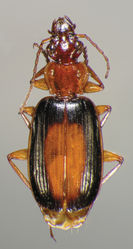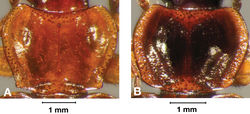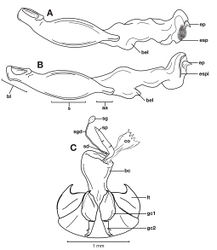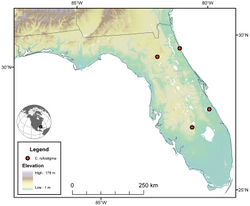Cymindis rufostigma
| Notice: | This page is derived from the original publication listed below, whose author(s) should always be credited. Further contributors may edit and improve the content of this page and, consequently, need to be credited as well (see page history). Any assessment of factual correctness requires a careful review of the original article as well as of subsequent contributions.
If you are uncertain whether your planned contribution is correct or not, we suggest that you use the associated discussion page instead of editing the page directly. This page should be cited as follows (rationale):
Citation formats to copy and paste
BibTeX: @article{Hunting2013ZooKeys259, RIS/ Endnote: TY - JOUR Wikipedia/ Citizendium: <ref name="Hunting2013ZooKeys259">{{Citation See also the citation download page at the journal. |
Ordo: Coleoptera
Familia: Carabidae
Genus: Cymindis
Name
Cymindis rufostigma Hunting sp. n. – Wikispecies link – ZooBank link – Pensoft Profile
Type material
Eleven specimens, labeled as follows. HOLOTYPE male, “FLORIDA: HIGHLANDS CO./ ARCHBOLD BIOL. STA./ 22.IX.1976/ L.L. LAMPERT, JR.”; “U. V. LIGHT” [handwritten]; “UASM#/141621,” [FSCA]. Ten additional PARATYPES, sex and label data as follows. Male, same as holotype except “UASM#/ 202040” [ABSC]. Male, same as holotype except “UASM#/ 141609” [FCSA]. Female, same as holotype except “…19.IV.1976; “UASM#/ 202044 ” [ABSC]. Female, same as holotype except “…17.IX.1977; “UASM#/ 202042” [ABSC]. Female, same as holotype except “…23.IX.1977; “UASM#/ 202041” [ABSC]. Female, same as holotype except “…3.IX.1981/ UVL [handwritten]”; “UASM#/ 202043” [ABSC]. Male, “FLORIDA ALACHUA CO.,/ AUSTIN CARY FOREST/ 28-VI-1976/ G. B. FAIRCHILD”; “INSECT LIGHT TRAP/ #2, CO2-BAITED”; “UASM/ 141619” [FSCA]. Male, “Austin Cary Forest [ handwritten]/ Alachua Co./ Fla. 21.VI.1961 [handwritten]/ ...Hetrick/ ...light trap” [handwritten, partially illegible]”; “UASM#/ 141620” [FSCA]. Female, “FLA. Indian River Co./ SR 512 .5 mi. W. I. 95/ 16-30-III-1977/ Fla. Med. Ent. Lab.”; “sorted from dusk;dawn/ suction trap sample in/ and near bayhead/ M. C. Thomas collection”; “ UASM#/ 141608” [FSCA]. Male, “St. Augustin/ Fla.”; “Liebeck/ Collection”; “UASM#/ 136905” (head missing) [MCZC].
Type locality
Archbold Biological Station, Highlands County, Florida, U.S.A.
Specific epithet
This is a two part feminine Latin noun in apposition, nominative case, based on the adjective rufus (red) and the noun stigma (mark), referring to the rufo-testaceous central mark on the elytra of adult members of this species.
Diagnosis
This species (Fig. 18) differs from others in the following ways: testaceous head and pronotum, pronotum with posteriolateral margins right- angled (Fig. 19A, cf. 19B) and elytra with large oblong rufous central macula. Male genitalia with distinct basal endophallic lobe (bel) (Fig. 20B).
Description
With character states of subgenus Pinacodera restricted as follows: OBL. 9.1 – 10.3 mm. Length (n= 7 males, 3 females): head 0.88 – 1.00 , pronotum 1.52 – 1.76, elytra 5.25 – 6.00, metepisternum 1.26 – 1.50 mm; width: head 1.72 – 2.00, pronotum 2.10 – 2.44, elytra 3.42 – 3.92, metepisternum 0.54 – 0.84 mm.
Body proportions. HW/HL 1.82 – 2.04; PWM/PL 1.29 – 1.45; EL/EW 1.48 – 1.58; ML/MW 1.92 – 2.41.
Color. Dorsum of head and pronotum rufous to rufo- testaceous; antennae rufo-testaceous to rufo-brunneous; palpi rufo-testaceous to brunneous; elytra brunneo-piceous to rufo-piceous with large oblong rufo-testaceous central macula and pale, somewhat translucent margins; elytral epipleura testaceous to rufo-testaceous; thoracic sclerites and abdominal sterna testaceous to rufo-piceous.
Microsculpture. Microlines not visible on dorsum of head capsule and pronotum at 50× magnification. Elytra with mesh pattern isodiametric, microlines clearly impressed throughout.
Macrosculpture and pilosity. Head capsule with shallow, randomly scattered setigerous punctures on dorsal surface from constriction of neck extended anteriorly toward clypeus. Elytra with striae moderately impressed and punctulate throughout length; intervals 2, 4, 6 and 8 typically with two to three rows of scattered punctures; all other intervals with one row of punctures; some specimens with intervals 1, 3 and 5 somewhat raised toward apex.
Metepisternum. Distinctly longer than wide.
Hind wings. Macropterous.
Male genitalia. Phallus (Fig. 20A) length 1.70 – 2.00 mm. Endophallus with basal endophallic lobe (bel) distinctly formed.
Habitat and seasonal occurrence
The known elevational range of Cymindis rufostigma extends from sea level to 65 m. Some specimens were collected in stands of slash pine. Methods of collecting include: dusk-dawn suction traps, u.v. light traps, CO2-baited insect light traps.
Geographical distribution
The range of this species extends from southern Florida north to northern Florida (Fig. 21).
Chorological affinities
Cymindis rufostigma is sympatric in portions of its range with Cymindis platicollis atripennis and Cymindis limbata. It is allopatric with Cymindis platicollis platicollis and all other species in the limbata group.
Material examined
The type material. See above for details.
Original Description
- Hunting, W; 2013: A taxonomic revision of the Cymindis (Pinacodera) limbata species group (Coleoptera, Carabidae, Lebiini), including description of a new species from Florida, U.S.A. ZooKeys, 259: 1-73. doi
Images
|



